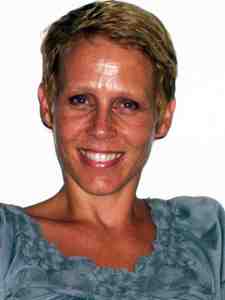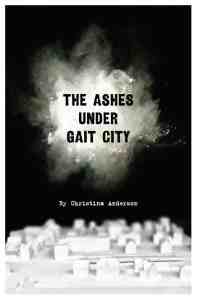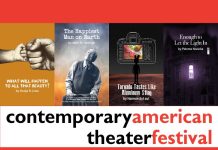This Special Edition of The Playwright’s Playground continues The Playmaker Series: CATF 2014. In a series of in depth conversations, I speak with the artistic teams associated with the plays at this year’s Contemporary American Theater Festival. Playwrights and the Directors share revealing behind the scene insights about their inspirations and the development of their new plays. It’s always refreshing and reaffirming to speak with artists who are not only passionate about the work they do, but are open about sharing their creative process and motivations.
Lucie Tiberghien

Lucie Tiberghien is the Director of the World Premiere of The Ashes Under Gait City by Christina Anderson at the Contemporary American Theater Festival 2014 in Shepherdstown, West Virginia. Her return to the Festival marks her sixth CATF production.
The bilingual French-born Theater Director has experienced a fully varied and diverse life. Besides directing, Lucie is a mother and she’s been a dancer, a choreographer, and has made a living as an Assistant Director in Opera. (She’s worked at Washington Opera.) She also has a degree in International Relations.
Her impressive theater credentials include directing the World Premiere of Love in Afghanistan by Charles Randolph at Arena Stage (2013-2014). Tiberghien has developed new plays at Sundance, the Oneil, the Orchard project, New Dramatists, the Playwright Center, TerraNOVA, and Playpenn where she will be working on Behind the Motel by Emily Schwend. In August at the Ojai New Play Festival she will work with Stew (Passing Strange) on his new musical, two zero zero one three.
Sydney-Chanele: You’ve directed classics, you’ve done operas, and you are no stranger to World Premieres. Is there a difference in your approach when you are working with a new play?
Lucie: Yes. But I think that I am always about the story whether I am doing a classic or a new play. When you are doing Moliere for example, you have to kinda dig to find the story because it is not immediately apparent. I’m looking for the story with new plays as well, but of course the difference with new plays is the writer in the room and if there are aspects of the story that needs to be illuminated or carved out, the writer is there to see if we can do it or not. Questions will often spark something in terms of a rewrite or in the shaping of a play.
When I am working on an existing play we just have to find the answers to all of these questions in the text as it is. But I spend a lot of time around the table with actors, and I spend a lot of time listening to what their experience of the text is. My process is an incredibly collaborative process once we are in the room. So I think that the questions that I ask are almost similar, but when the new play is in process these questions naturally create change. If change needs to happen.
What is the tone of The Ashes Under Gait City, and what themes emerged through your process and the rewrites?
The play is as much about race as it is about the nature of cults. Interestingly enough, I don’t know if that is easily apparent. I think it sneaks up on you, almost in the same way this cult aspect of this movement sneaks up on the members in this community. I think what I admire about Christina’s work in this play is how textured and layered and complex she is making all of these relationships. Nothing is simple.
It’s interesting, I always look for clarity-and I think she wants clarity, but very complex, textured clarity. I think that was great for me and I appreciate her ability to articulate that complexity. Nothing is simple in this play.
Everything is so complex. It’s such a cliche but it’s really great when the playwright is invested in examining that complexity. It’s also a play that is a very slow burn towards this final event. For me as a Director it’s about creating this tension and never allowing the ball drop. It’s not like there is going to be an event that’s going to bring it up again. The ball just has to stay there – up in the air from the beginning – and it slowly, slowly, rises.
And Christina’s words are like that too; there’s a lot about the way you she chooses to deliver dialogue that has to do with back and forth, back and forth, back and forth. And if the ball drops the tension falls. Technically for the actors it’s interesting. It demands a real discipline.
By discipline, what do you mean?
I mean it’s almost like doing classical work in the sense you can’t embrace a real naturalistic way of talking and acting. You have to be about language – clear and focused. You have to step into it. You can’t be laid back about it. Her text does not allow that at all.
Is that a challenge for you as a director with a contemporary play?
It’s a type of challenge, yes. But it is absolutely the type of challenge that I love! I am very interested in the places where theater is not television. I think we are in trouble when our theater starts feeling like television.
Expand upon that. What do you think about the state of theater today and the popularity of television?
I think television right now is having such a moment. The writing in television is incredible. We as theater artists, I think have to remember what is unique about the live experience of theater and we have to be able to provide an experience that will be utterly different than the experience of sitting in front of a screen and watching TV. It’s about language, it’s about characters, it’s about form, and it’s about embracing what theater can do that television cannot do. I feel that The Ashes Under Gait City is absolutely doing that.
As the Director of The Ashes Under Gait City, what questions did you have for Playwright Christina Anderson when you first read the script?
I think it was probably two-fold. One hand I probably wanted to talk about story. I wanted to very simply talk about who are these people, where did they come from, why are they making these decisions. How are their stories all different? How do they go from A-B-C in this play, and end up at this place in the end? So for me it was really filling the gaps – not that the gaps needed to be filled in the script – but for me as a Director in terms of telling a clear story.
A lot of the work that we did around the table with everyone was trying to get a clear picture of how we go from one place to the next in the script based on who the characters are and what just happened.
One the other hand I was incredibly curious about learning more about civil rights in the Pacific Northwest and the particular historical background and social background that this play was set in. I was very curious about Christina’s quote near the beginning of the script about ‘not being truly black.’ It’s this whole notion of post black. So I wanted to talk to her about that and I wanted her to tell me what that meant for her in respect to this play.
So, these are questions of identity. In the context of this play, you had questions of what does it mean to be black?
Yes. Yes, exactly. It was interesting at one point I said the descriptions in the script are actually notes for the Director to let the actors in this play find who these people are based simply on who they are as individuals, and not reverting to what are the stereotypes. It was a great discussion and to hear everybody around the table talk about what it meant to them as individuals.
What specific, additional research did you do with The Ashes Under Gait City?
Well the dramaturg Theresa M. Davis was incredible in terms of providing research. I read a lot of history about the Civil Rights movement in the Pacific Northwest particularly, and I read a lot about this notion of post-black and post-racial that I had not read a lot about beforehand. There is a character in the play whose father is shot, and I was interested in Black Nationalism, and understanding Black Power. There is a portion that I felt I needed to understand and learn more about. I had never watched the entire Eyes on the Prize – it’s incredible. I sat there and did an episode every night. It was incredible – very, very, informative.
What did you learn from those conversations?
I learned that they were looking very forward to feeling free in this room and with this play. And that Christina was trying to break from the stereotypes, break from the past – even though she’s writing a play about history and its consequences.
It’s interesting to me that we have people from all over the country as actors and they are of course a product of where they come from in the country. But also, it’s interesting for me because I didn’t grow up here. I grew up in Ferney -Voltaire, France, a small town outside of Geneva, Switzerland. So I’ve always felt a little outside of the dichotomy here, and I’ve always felt a little of an observer rather than somebody who is inside it.
You have this history and international studies background, and I know you also studied dance. When and how did your love of theater and storytelling come about?
That’s a good question and I’ve not really thought about that. Actually, I think that’s why I moved away from dance. My dancing transferred into choreography, and then after I graduated from college I decided to move to New York and study Theater. It was completely an evolution of my dance. Theater just felt like the place where I would be able to use music, movement, dance, and in a way history and political science.
This is where the two worlds for me were going to meet. In the end I wanted to tell stories. Dance tells stories in many ways, but there’s something about language and words that excites me. Nothing excites me more than doing Moliere or Chekhov. And in this particular play, The Ashes Under Gait City, my Lord, her language is so beautiful, and specific – the rhythm of it. It’s really exciting. Christina’s use of language is really exciting to me.
You directed the World Premiere of Love and Afghanistan this past season at Arena stage. What attracts you to these complex new plays involving other cultures?
It’s who I am. I’m French and American and I grew up in a bi-cultural, bilingual household. I’ve traveled a lot, studied history and political science, and graduated with a degree in International Studies from Webster University. I’m very interested in history and international relations. I go where my interests are.
I think we are political and social individuals and I’m interested in the place where politics and individuality meet. I think you can’t really separate yourself. So plays that tell stories and have a larger political and social context are the plays that will always interest me.
Maybe you answered this with what you just said, but what attracts you to storytelling – directing plays – that involve such large canvases?
As individuals we are a product of our history and the country that we live in. We don’t exist in a vacuum, and we have that relationship whether we want it or not, whether we are aware of it or not, and whether we are active in it, we have a relationship with how our country operates. I think that I am interested in plays where that relationship comes into play – plays that shed light and ask questions about how we operate as individuals, as members of society.
That’s a good segue back into Ashes. What can you tell me about the complexities of the Simone the Believer character?

She just lost her mother, and she’s trying to redefine herself in light of that sudden lost. She’s one of these people who are not always aware of the power that they have over people. I think people change without her having to consciously make that happen – but they change in her presence – and I’m not sure how much she is aware of that. Sometimes it’s for the better and sometimes not, but I’m not sure that she intends to do it one way or the other.
If the creation of this Gait City community was built out of a need, what does Simone the Believer and others feel like they are missing?
I think it’s as much an individual statement as it is a political statement. Simone the Believer isdefinitely an activist in this movement, and she feels like that the black community in Gait City has been left out because of the fire. They were not invited to come back, and it was their due in a way, to come back and create this community. She feels like that this can be a place for those who have felt boxed out in any way, shape, or form.
Having experienced and worked through this play. Can one be an activist and artist at the same time?
I think we can. I’d like to think that we can. For me if somebody comes to see a play and they leave with a question – How do I exist in my community? How do I exist in my family? What am I doing and how can I be active in my life? Then I think that is a form of activism. If we are able as theater artists to make that question happen, it’s one way to be active.
What are your thoughts on the disproportionate number of female playwrights consistently being programmed by theater companies?
I think there is a lot of work being done to look at that. Ed Herendeen’s record is amazing in terms of producing women at CATF. I think there is a very good important conversation around that right now. Are things moving in the right direction fast enough – probably not?
What would you like to see happen?
Oh, God. To be perfectly honest I’ve thought more about the role of women in society, than I’ve thought about female playwrights. I might have placed myself personally as a mother and a theater artist, and I’m married to a playwright, that I find that I have particular challenges. A lot of work needs to be done to help women in the world do their work and be parents at the same time. I think I have thought more about that, than the particular challenge of being a woman playwright and getting one’s work produced.
I think we still live in a very male centric world, and everything gets filtered through that – still. I would like to see that change.
LINKS:
The Playwright’s Playground: The Playmakers CATF 2014: An Interview with Director Lucie Tiberghien (‘The Ashes Under Gait City’)
The Playwright’s Playground: The Playmakers CATF 2014: An Interview with Playwright Christina Anderson(The Ashes Under Gait City)
The Playwright’s Playground: The Playmakers CATF 2014: Ed Herendeen & Peggy McKowen Discuss the Development of CATF Plays
The Playwright’s Playground: The Playmakers – CATF 2014: Interview With Ed Herendeen & Peggy McKowen Who Preview The Season
Lucie Tiberghien – About the Artists page.
Clip from Love in Afghanistan.
The Playwright’s Playground is a monthly in-depth conversation with local female playwright in the D.C. theatre community. Female theatre artists make up more than 50 percent of those involved in the theatre, yet the number of female playwrights being produced is dramatically lower. In this continuing Column, I will also interview and introduce DCMTA readers to the many talented playwrights in the DMV area to learn about their writing process, their inspirations, and their motivations and struggles to write and produce their art. Sydney-Chanele Dawkins.




